A Study on Meditation Therapy's Impact on Adult Blood Pressure Levels
VerifiedAdded on 2020/05/04
|18
|3709
|138
Project
AI Summary
This project report, submitted by Rupinder Kaur, investigates the effectiveness of meditation therapy in controlling blood pressure among adults in Nelson town of Island. The study aims to determine if meditation can impact blood pressure levels, focusing on a population aged 18-50 years. The research includes a literature review on hypertension, meditation, and their relationship. The methodology involves a simple random sampling technique, dividing participants into meditation and non-meditation groups. Data collection includes measuring systolic and diastolic blood pressure, heart rate, and other variables. The report details the study's procedures, ethical considerations, and potential biases. The analysis and interpretation of data, presented in the form of a table with participants' data, is included. The project concludes with a discussion of the findings, a conclusion, and references. The study's limitations include the sample size and location, with a focus on the potential benefits of meditation as a non-invasive and cost-effective treatment for hypertension.
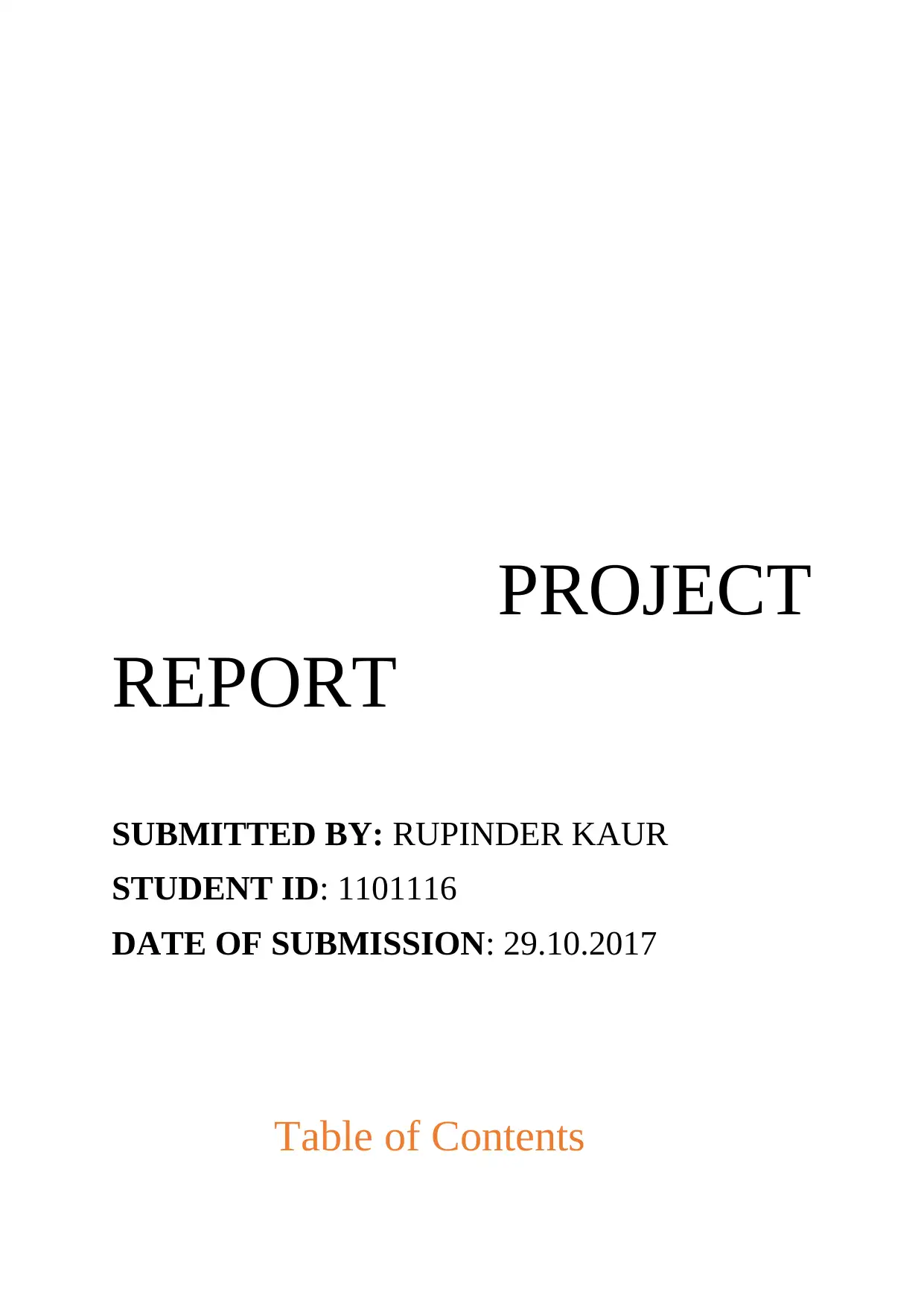
PROJECT
REPORT
SUBMITTED BY: RUPINDER KAUR
STUDENT ID: 1101116
DATE OF SUBMISSION: 29.10.2017
Table of Contents
REPORT
SUBMITTED BY: RUPINDER KAUR
STUDENT ID: 1101116
DATE OF SUBMISSION: 29.10.2017
Table of Contents
Paraphrase This Document
Need a fresh take? Get an instant paraphrase of this document with our AI Paraphraser
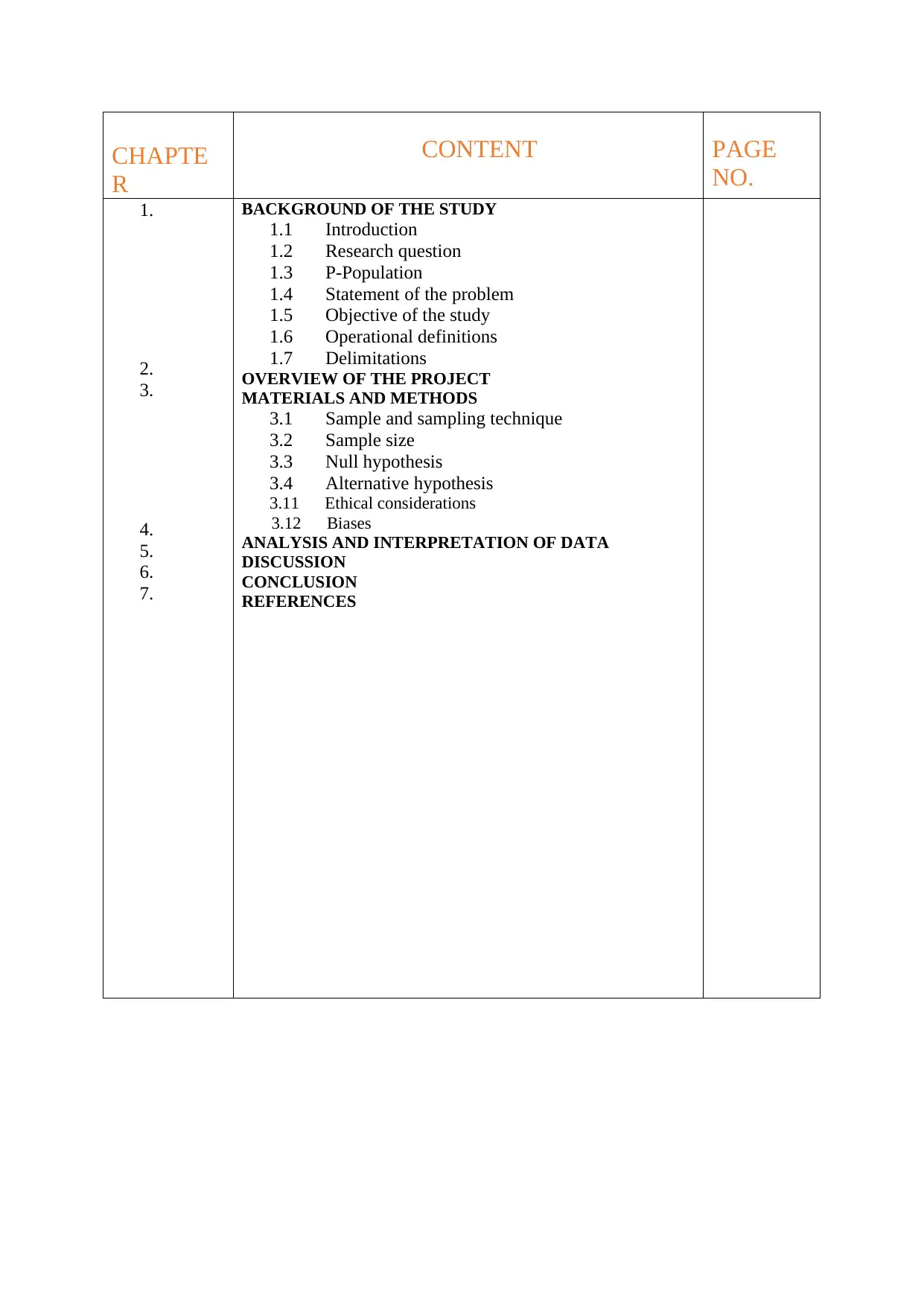
CHAPTE
R
CONTENT PAGE
NO.
1.
2.
3.
4.
5.
6.
7.
BACKGROUND OF THE STUDY
1.1 Introduction
1.2 Research question
1.3 P-Population
1.4 Statement of the problem
1.5 Objective of the study
1.6 Operational definitions
1.7 Delimitations
OVERVIEW OF THE PROJECT
MATERIALS AND METHODS
3.1 Sample and sampling technique
3.2 Sample size
3.3 Null hypothesis
3.4 Alternative hypothesis
3.11 Ethical considerations
3.12 Biases
ANALYSIS AND INTERPRETATION OF DATA
DISCUSSION
CONCLUSION
REFERENCES
R
CONTENT PAGE
NO.
1.
2.
3.
4.
5.
6.
7.
BACKGROUND OF THE STUDY
1.1 Introduction
1.2 Research question
1.3 P-Population
1.4 Statement of the problem
1.5 Objective of the study
1.6 Operational definitions
1.7 Delimitations
OVERVIEW OF THE PROJECT
MATERIALS AND METHODS
3.1 Sample and sampling technique
3.2 Sample size
3.3 Null hypothesis
3.4 Alternative hypothesis
3.11 Ethical considerations
3.12 Biases
ANALYSIS AND INTERPRETATION OF DATA
DISCUSSION
CONCLUSION
REFERENCES
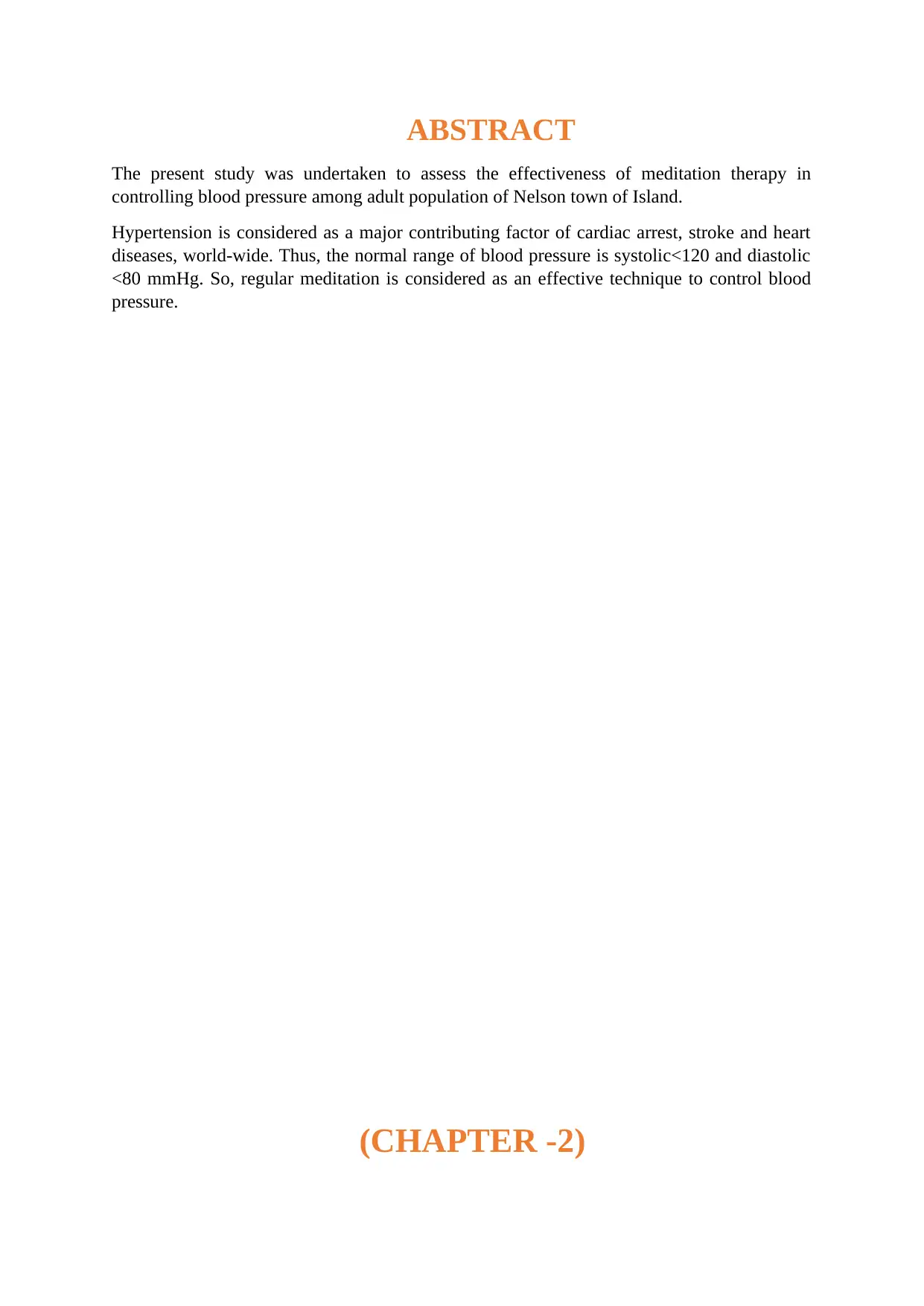
ABSTRACT
The present study was undertaken to assess the effectiveness of meditation therapy in
controlling blood pressure among adult population of Nelson town of Island.
Hypertension is considered as a major contributing factor of cardiac arrest, stroke and heart
diseases, world-wide. Thus, the normal range of blood pressure is systolic<120 and diastolic
<80 mmHg. So, regular meditation is considered as an effective technique to control blood
pressure.
(CHAPTER -2)
The present study was undertaken to assess the effectiveness of meditation therapy in
controlling blood pressure among adult population of Nelson town of Island.
Hypertension is considered as a major contributing factor of cardiac arrest, stroke and heart
diseases, world-wide. Thus, the normal range of blood pressure is systolic<120 and diastolic
<80 mmHg. So, regular meditation is considered as an effective technique to control blood
pressure.
(CHAPTER -2)
⊘ This is a preview!⊘
Do you want full access?
Subscribe today to unlock all pages.

Trusted by 1+ million students worldwide
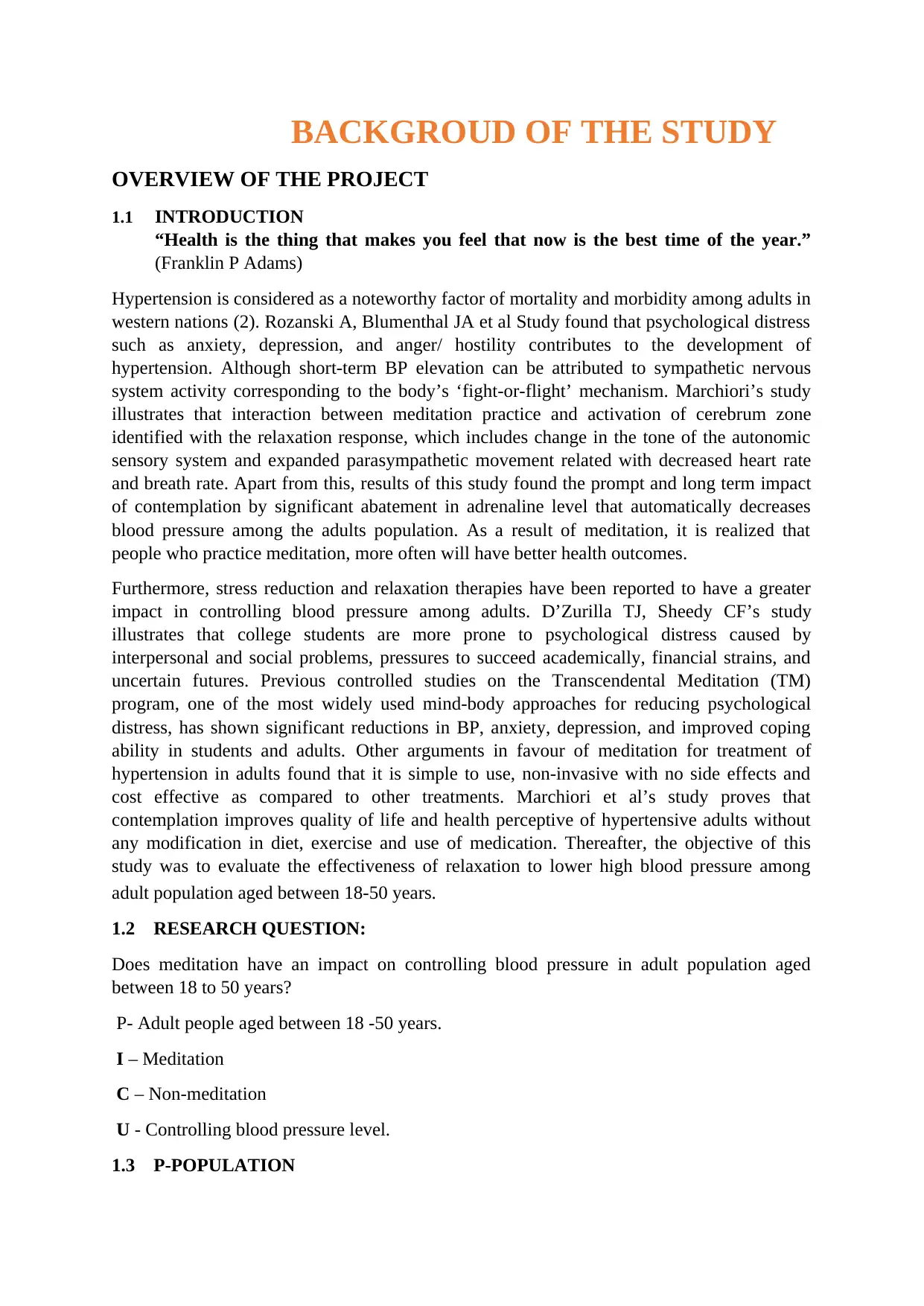
BACKGROUD OF THE STUDY
OVERVIEW OF THE PROJECT
1.1 INTRODUCTION
“Health is the thing that makes you feel that now is the best time of the year.”
(Franklin P Adams)
Hypertension is considered as a noteworthy factor of mortality and morbidity among adults in
western nations (2). Rozanski A, Blumenthal JA et al Study found that psychological distress
such as anxiety, depression, and anger/ hostility contributes to the development of
hypertension. Although short-term BP elevation can be attributed to sympathetic nervous
system activity corresponding to the body’s ‘fight-or-flight’ mechanism. Marchiori’s study
illustrates that interaction between meditation practice and activation of cerebrum zone
identified with the relaxation response, which includes change in the tone of the autonomic
sensory system and expanded parasympathetic movement related with decreased heart rate
and breath rate. Apart from this, results of this study found the prompt and long term impact
of contemplation by significant abatement in adrenaline level that automatically decreases
blood pressure among the adults population. As a result of meditation, it is realized that
people who practice meditation, more often will have better health outcomes.
Furthermore, stress reduction and relaxation therapies have been reported to have a greater
impact in controlling blood pressure among adults. D’Zurilla TJ, Sheedy CF’s study
illustrates that college students are more prone to psychological distress caused by
interpersonal and social problems, pressures to succeed academically, financial strains, and
uncertain futures. Previous controlled studies on the Transcendental Meditation (TM)
program, one of the most widely used mind-body approaches for reducing psychological
distress, has shown significant reductions in BP, anxiety, depression, and improved coping
ability in students and adults. Other arguments in favour of meditation for treatment of
hypertension in adults found that it is simple to use, non-invasive with no side effects and
cost effective as compared to other treatments. Marchiori et al’s study proves that
contemplation improves quality of life and health perceptive of hypertensive adults without
any modification in diet, exercise and use of medication. Thereafter, the objective of this
study was to evaluate the effectiveness of relaxation to lower high blood pressure among
adult population aged between 18-50 years.
1.2 RESEARCH QUESTION:
Does meditation have an impact on controlling blood pressure in adult population aged
between 18 to 50 years?
P- Adult people aged between 18 -50 years.
I – Meditation
C – Non-meditation
U - Controlling blood pressure level.
1.3 P-POPULATION
OVERVIEW OF THE PROJECT
1.1 INTRODUCTION
“Health is the thing that makes you feel that now is the best time of the year.”
(Franklin P Adams)
Hypertension is considered as a noteworthy factor of mortality and morbidity among adults in
western nations (2). Rozanski A, Blumenthal JA et al Study found that psychological distress
such as anxiety, depression, and anger/ hostility contributes to the development of
hypertension. Although short-term BP elevation can be attributed to sympathetic nervous
system activity corresponding to the body’s ‘fight-or-flight’ mechanism. Marchiori’s study
illustrates that interaction between meditation practice and activation of cerebrum zone
identified with the relaxation response, which includes change in the tone of the autonomic
sensory system and expanded parasympathetic movement related with decreased heart rate
and breath rate. Apart from this, results of this study found the prompt and long term impact
of contemplation by significant abatement in adrenaline level that automatically decreases
blood pressure among the adults population. As a result of meditation, it is realized that
people who practice meditation, more often will have better health outcomes.
Furthermore, stress reduction and relaxation therapies have been reported to have a greater
impact in controlling blood pressure among adults. D’Zurilla TJ, Sheedy CF’s study
illustrates that college students are more prone to psychological distress caused by
interpersonal and social problems, pressures to succeed academically, financial strains, and
uncertain futures. Previous controlled studies on the Transcendental Meditation (TM)
program, one of the most widely used mind-body approaches for reducing psychological
distress, has shown significant reductions in BP, anxiety, depression, and improved coping
ability in students and adults. Other arguments in favour of meditation for treatment of
hypertension in adults found that it is simple to use, non-invasive with no side effects and
cost effective as compared to other treatments. Marchiori et al’s study proves that
contemplation improves quality of life and health perceptive of hypertensive adults without
any modification in diet, exercise and use of medication. Thereafter, the objective of this
study was to evaluate the effectiveness of relaxation to lower high blood pressure among
adult population aged between 18-50 years.
1.2 RESEARCH QUESTION:
Does meditation have an impact on controlling blood pressure in adult population aged
between 18 to 50 years?
P- Adult people aged between 18 -50 years.
I – Meditation
C – Non-meditation
U - Controlling blood pressure level.
1.3 P-POPULATION
Paraphrase This Document
Need a fresh take? Get an instant paraphrase of this document with our AI Paraphraser
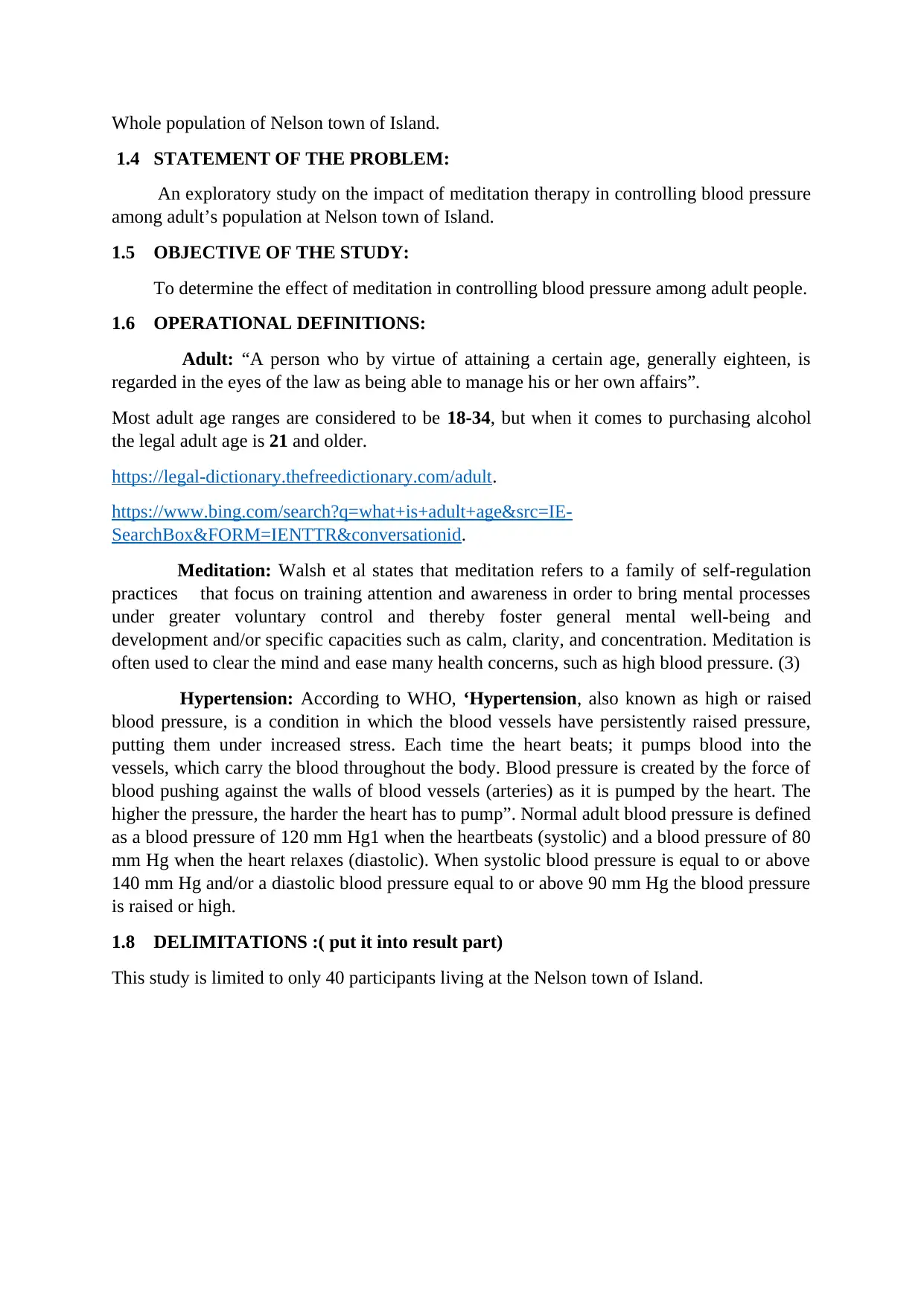
Whole population of Nelson town of Island.
1.4 STATEMENT OF THE PROBLEM:
An exploratory study on the impact of meditation therapy in controlling blood pressure
among adult’s population at Nelson town of Island.
1.5 OBJECTIVE OF THE STUDY:
To determine the effect of meditation in controlling blood pressure among adult people.
1.6 OPERATIONAL DEFINITIONS:
Adult: “A person who by virtue of attaining a certain age, generally eighteen, is
regarded in the eyes of the law as being able to manage his or her own affairs”.
Most adult age ranges are considered to be 18-34, but when it comes to purchasing alcohol
the legal adult age is 21 and older.
https://legal-dictionary.thefreedictionary.com/adult.
https://www.bing.com/search?q=what+is+adult+age&src=IE-
SearchBox&FORM=IENTTR&conversationid.
Meditation: Walsh et al states that meditation refers to a family of self-regulation
practices that focus on training attention and awareness in order to bring mental processes
under greater voluntary control and thereby foster general mental well-being and
development and/or specific capacities such as calm, clarity, and concentration. Meditation is
often used to clear the mind and ease many health concerns, such as high blood pressure. (3)
Hypertension: According to WHO, ‘Hypertension, also known as high or raised
blood pressure, is a condition in which the blood vessels have persistently raised pressure,
putting them under increased stress. Each time the heart beats; it pumps blood into the
vessels, which carry the blood throughout the body. Blood pressure is created by the force of
blood pushing against the walls of blood vessels (arteries) as it is pumped by the heart. The
higher the pressure, the harder the heart has to pump”. Normal adult blood pressure is defined
as a blood pressure of 120 mm Hg1 when the heartbeats (systolic) and a blood pressure of 80
mm Hg when the heart relaxes (diastolic). When systolic blood pressure is equal to or above
140 mm Hg and/or a diastolic blood pressure equal to or above 90 mm Hg the blood pressure
is raised or high.
1.8 DELIMITATIONS :( put it into result part)
This study is limited to only 40 participants living at the Nelson town of Island.
1.4 STATEMENT OF THE PROBLEM:
An exploratory study on the impact of meditation therapy in controlling blood pressure
among adult’s population at Nelson town of Island.
1.5 OBJECTIVE OF THE STUDY:
To determine the effect of meditation in controlling blood pressure among adult people.
1.6 OPERATIONAL DEFINITIONS:
Adult: “A person who by virtue of attaining a certain age, generally eighteen, is
regarded in the eyes of the law as being able to manage his or her own affairs”.
Most adult age ranges are considered to be 18-34, but when it comes to purchasing alcohol
the legal adult age is 21 and older.
https://legal-dictionary.thefreedictionary.com/adult.
https://www.bing.com/search?q=what+is+adult+age&src=IE-
SearchBox&FORM=IENTTR&conversationid.
Meditation: Walsh et al states that meditation refers to a family of self-regulation
practices that focus on training attention and awareness in order to bring mental processes
under greater voluntary control and thereby foster general mental well-being and
development and/or specific capacities such as calm, clarity, and concentration. Meditation is
often used to clear the mind and ease many health concerns, such as high blood pressure. (3)
Hypertension: According to WHO, ‘Hypertension, also known as high or raised
blood pressure, is a condition in which the blood vessels have persistently raised pressure,
putting them under increased stress. Each time the heart beats; it pumps blood into the
vessels, which carry the blood throughout the body. Blood pressure is created by the force of
blood pushing against the walls of blood vessels (arteries) as it is pumped by the heart. The
higher the pressure, the harder the heart has to pump”. Normal adult blood pressure is defined
as a blood pressure of 120 mm Hg1 when the heartbeats (systolic) and a blood pressure of 80
mm Hg when the heart relaxes (diastolic). When systolic blood pressure is equal to or above
140 mm Hg and/or a diastolic blood pressure equal to or above 90 mm Hg the blood pressure
is raised or high.
1.8 DELIMITATIONS :( put it into result part)
This study is limited to only 40 participants living at the Nelson town of Island.
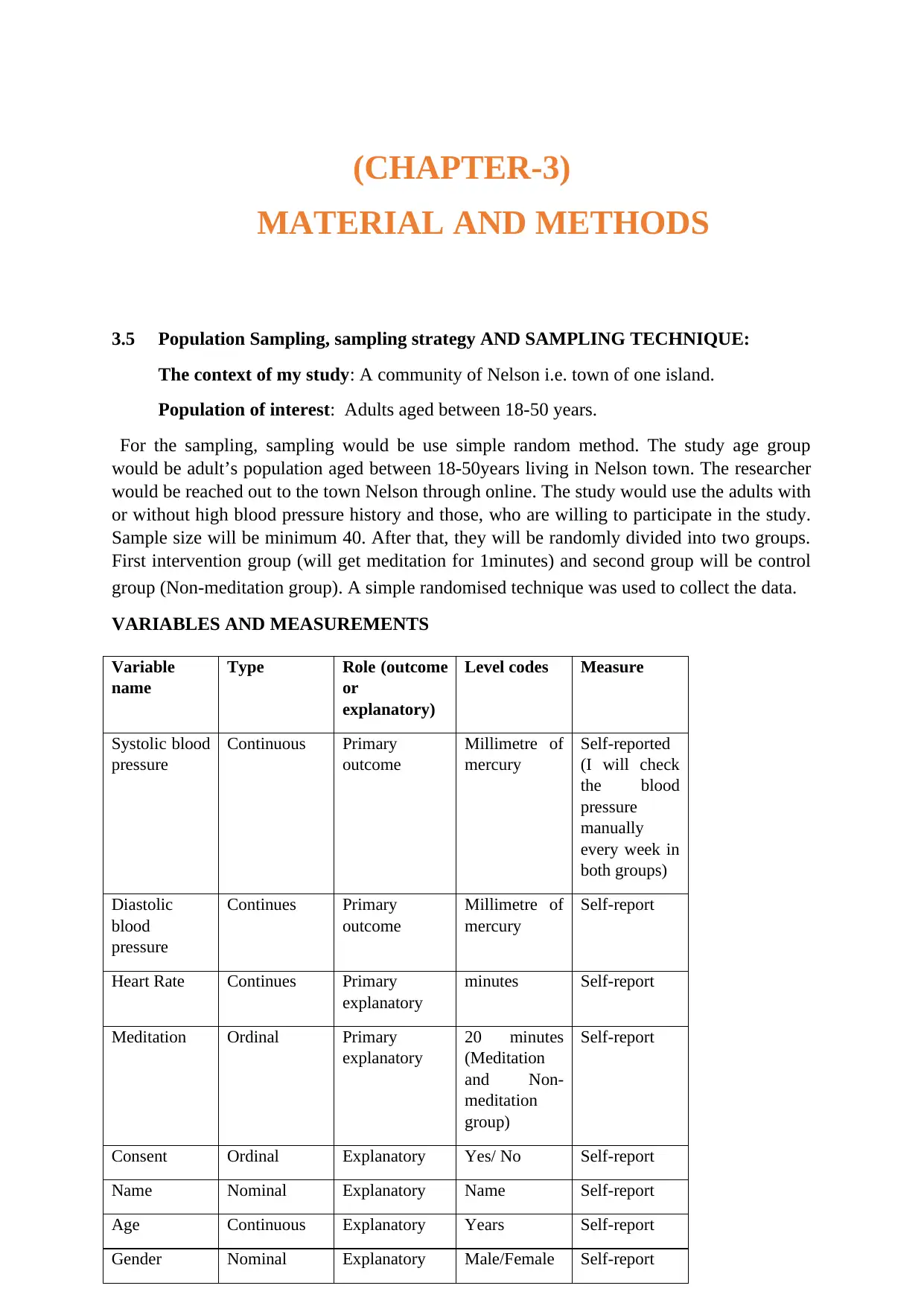
(CHAPTER-3)
MATERIAL AND METHODS
3.5 Population Sampling, sampling strategy AND SAMPLING TECHNIQUE:
The context of my study: A community of Nelson i.e. town of one island.
Population of interest: Adults aged between 18-50 years.
For the sampling, sampling would be use simple random method. The study age group
would be adult’s population aged between 18-50years living in Nelson town. The researcher
would be reached out to the town Nelson through online. The study would use the adults with
or without high blood pressure history and those, who are willing to participate in the study.
Sample size will be minimum 40. After that, they will be randomly divided into two groups.
First intervention group (will get meditation for 1minutes) and second group will be control
group (Non-meditation group). A simple randomised technique was used to collect the data.
VARIABLES AND MEASUREMENTS
Variable
name
Type Role (outcome
or
explanatory)
Level codes Measure
Systolic blood
pressure
Continuous Primary
outcome
Millimetre of
mercury
Self-reported
(I will check
the blood
pressure
manually
every week in
both groups)
Diastolic
blood
pressure
Continues Primary
outcome
Millimetre of
mercury
Self-report
Heart Rate Continues Primary
explanatory
minutes Self-report
Meditation Ordinal Primary
explanatory
20 minutes
(Meditation
and Non-
meditation
group)
Self-report
Consent Ordinal Explanatory Yes/ No Self-report
Name Nominal Explanatory Name Self-report
Age Continuous Explanatory Years Self-report
Gender Nominal Explanatory Male/Female Self-report
MATERIAL AND METHODS
3.5 Population Sampling, sampling strategy AND SAMPLING TECHNIQUE:
The context of my study: A community of Nelson i.e. town of one island.
Population of interest: Adults aged between 18-50 years.
For the sampling, sampling would be use simple random method. The study age group
would be adult’s population aged between 18-50years living in Nelson town. The researcher
would be reached out to the town Nelson through online. The study would use the adults with
or without high blood pressure history and those, who are willing to participate in the study.
Sample size will be minimum 40. After that, they will be randomly divided into two groups.
First intervention group (will get meditation for 1minutes) and second group will be control
group (Non-meditation group). A simple randomised technique was used to collect the data.
VARIABLES AND MEASUREMENTS
Variable
name
Type Role (outcome
or
explanatory)
Level codes Measure
Systolic blood
pressure
Continuous Primary
outcome
Millimetre of
mercury
Self-reported
(I will check
the blood
pressure
manually
every week in
both groups)
Diastolic
blood
pressure
Continues Primary
outcome
Millimetre of
mercury
Self-report
Heart Rate Continues Primary
explanatory
minutes Self-report
Meditation Ordinal Primary
explanatory
20 minutes
(Meditation
and Non-
meditation
group)
Self-report
Consent Ordinal Explanatory Yes/ No Self-report
Name Nominal Explanatory Name Self-report
Age Continuous Explanatory Years Self-report
Gender Nominal Explanatory Male/Female Self-report
⊘ This is a preview!⊘
Do you want full access?
Subscribe today to unlock all pages.

Trusted by 1+ million students worldwide
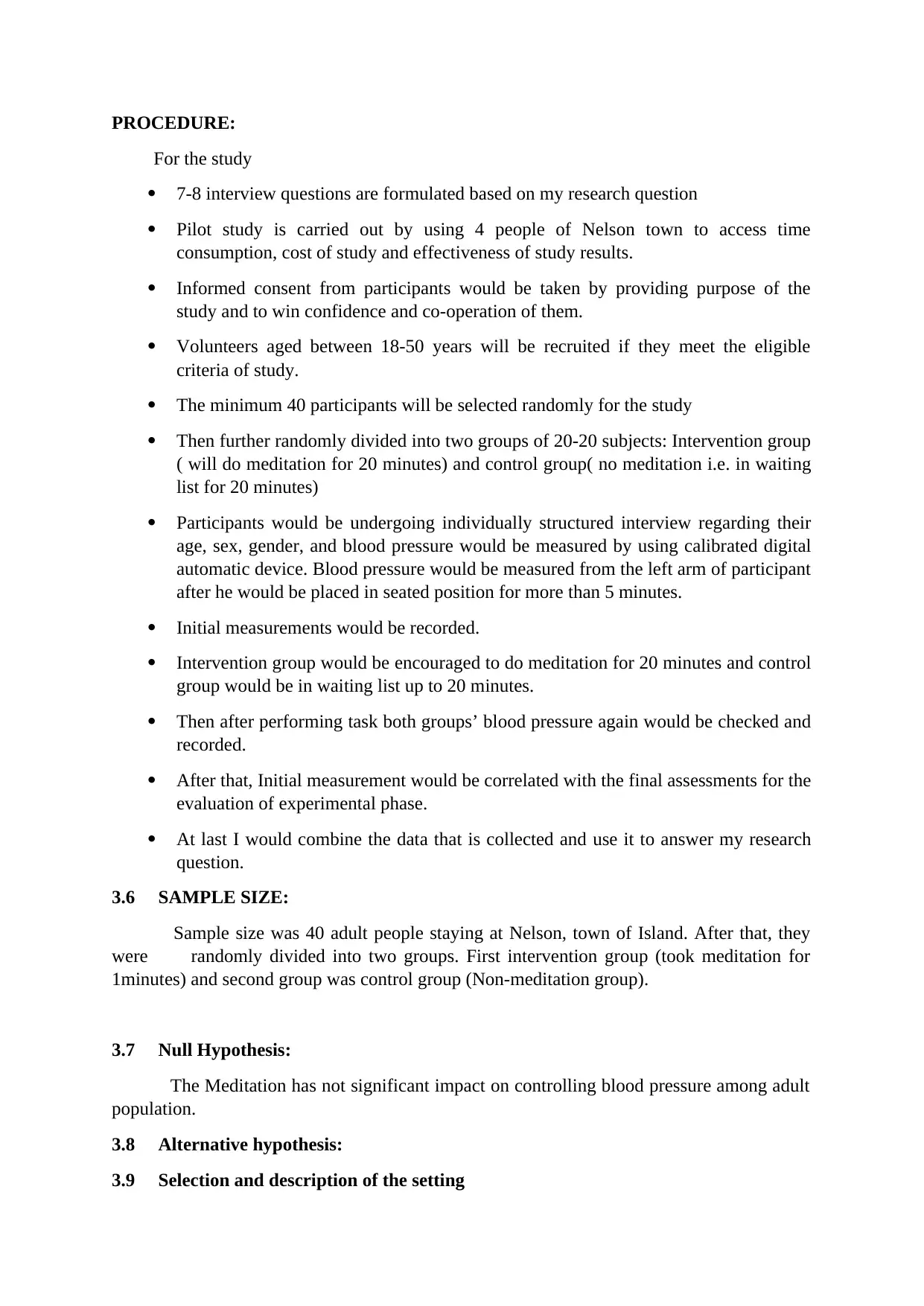
PROCEDURE:
For the study
7-8 interview questions are formulated based on my research question
Pilot study is carried out by using 4 people of Nelson town to access time
consumption, cost of study and effectiveness of study results.
Informed consent from participants would be taken by providing purpose of the
study and to win confidence and co-operation of them.
Volunteers aged between 18-50 years will be recruited if they meet the eligible
criteria of study.
The minimum 40 participants will be selected randomly for the study
Then further randomly divided into two groups of 20-20 subjects: Intervention group
( will do meditation for 20 minutes) and control group( no meditation i.e. in waiting
list for 20 minutes)
Participants would be undergoing individually structured interview regarding their
age, sex, gender, and blood pressure would be measured by using calibrated digital
automatic device. Blood pressure would be measured from the left arm of participant
after he would be placed in seated position for more than 5 minutes.
Initial measurements would be recorded.
Intervention group would be encouraged to do meditation for 20 minutes and control
group would be in waiting list up to 20 minutes.
Then after performing task both groups’ blood pressure again would be checked and
recorded.
After that, Initial measurement would be correlated with the final assessments for the
evaluation of experimental phase.
At last I would combine the data that is collected and use it to answer my research
question.
3.6 SAMPLE SIZE:
Sample size was 40 adult people staying at Nelson, town of Island. After that, they
were randomly divided into two groups. First intervention group (took meditation for
1minutes) and second group was control group (Non-meditation group).
3.7 Null Hypothesis:
The Meditation has not significant impact on controlling blood pressure among adult
population.
3.8 Alternative hypothesis:
3.9 Selection and description of the setting
For the study
7-8 interview questions are formulated based on my research question
Pilot study is carried out by using 4 people of Nelson town to access time
consumption, cost of study and effectiveness of study results.
Informed consent from participants would be taken by providing purpose of the
study and to win confidence and co-operation of them.
Volunteers aged between 18-50 years will be recruited if they meet the eligible
criteria of study.
The minimum 40 participants will be selected randomly for the study
Then further randomly divided into two groups of 20-20 subjects: Intervention group
( will do meditation for 20 minutes) and control group( no meditation i.e. in waiting
list for 20 minutes)
Participants would be undergoing individually structured interview regarding their
age, sex, gender, and blood pressure would be measured by using calibrated digital
automatic device. Blood pressure would be measured from the left arm of participant
after he would be placed in seated position for more than 5 minutes.
Initial measurements would be recorded.
Intervention group would be encouraged to do meditation for 20 minutes and control
group would be in waiting list up to 20 minutes.
Then after performing task both groups’ blood pressure again would be checked and
recorded.
After that, Initial measurement would be correlated with the final assessments for the
evaluation of experimental phase.
At last I would combine the data that is collected and use it to answer my research
question.
3.6 SAMPLE SIZE:
Sample size was 40 adult people staying at Nelson, town of Island. After that, they
were randomly divided into two groups. First intervention group (took meditation for
1minutes) and second group was control group (Non-meditation group).
3.7 Null Hypothesis:
The Meditation has not significant impact on controlling blood pressure among adult
population.
3.8 Alternative hypothesis:
3.9 Selection and description of the setting
Paraphrase This Document
Need a fresh take? Get an instant paraphrase of this document with our AI Paraphraser
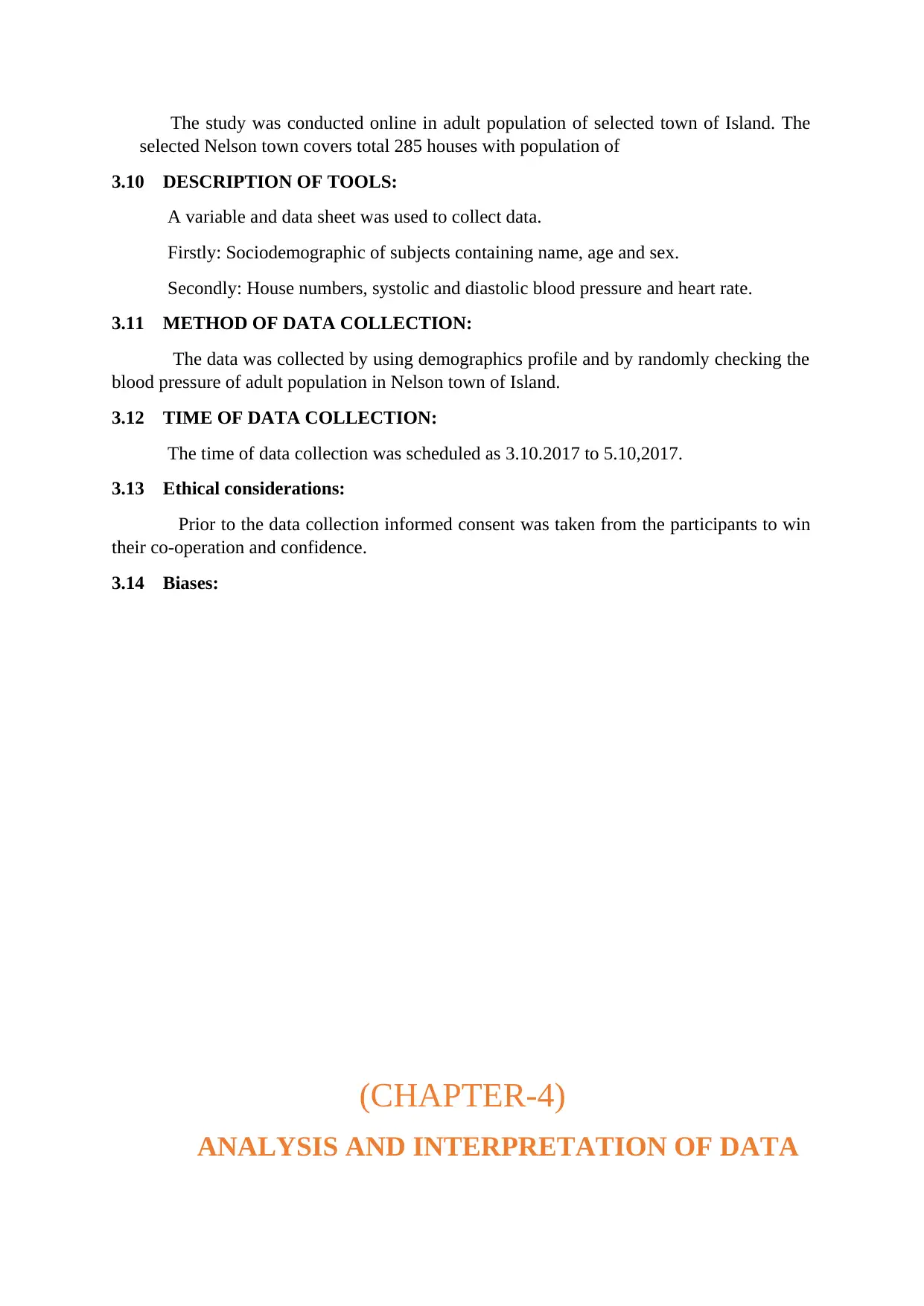
The study was conducted online in adult population of selected town of Island. The
selected Nelson town covers total 285 houses with population of
3.10 DESCRIPTION OF TOOLS:
A variable and data sheet was used to collect data.
Firstly: Sociodemographic of subjects containing name, age and sex.
Secondly: House numbers, systolic and diastolic blood pressure and heart rate.
3.11 METHOD OF DATA COLLECTION:
The data was collected by using demographics profile and by randomly checking the
blood pressure of adult population in Nelson town of Island.
3.12 TIME OF DATA COLLECTION:
The time of data collection was scheduled as 3.10.2017 to 5.10,2017.
3.13 Ethical considerations:
Prior to the data collection informed consent was taken from the participants to win
their co-operation and confidence.
3.14 Biases:
(CHAPTER-4)
ANALYSIS AND INTERPRETATION OF DATA
selected Nelson town covers total 285 houses with population of
3.10 DESCRIPTION OF TOOLS:
A variable and data sheet was used to collect data.
Firstly: Sociodemographic of subjects containing name, age and sex.
Secondly: House numbers, systolic and diastolic blood pressure and heart rate.
3.11 METHOD OF DATA COLLECTION:
The data was collected by using demographics profile and by randomly checking the
blood pressure of adult population in Nelson town of Island.
3.12 TIME OF DATA COLLECTION:
The time of data collection was scheduled as 3.10.2017 to 5.10,2017.
3.13 Ethical considerations:
Prior to the data collection informed consent was taken from the participants to win
their co-operation and confidence.
3.14 Biases:
(CHAPTER-4)
ANALYSIS AND INTERPRETATION OF DATA
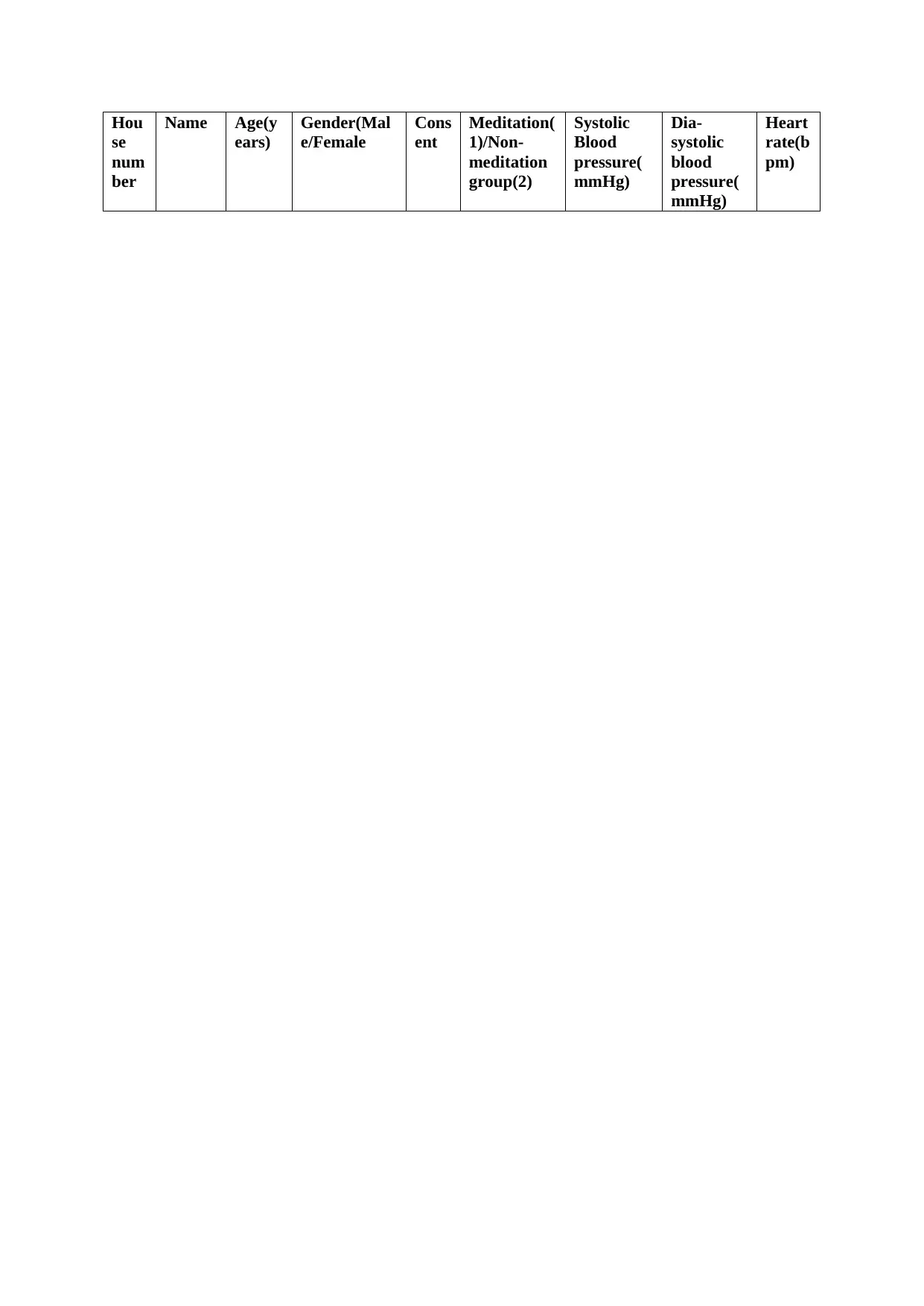
Hou
se
num
ber
Name Age(y
ears)
Gender(Mal
e/Female
Cons
ent
Meditation(
1)/Non-
meditation
group(2)
Systolic
Blood
pressure(
mmHg)
Dia-
systolic
blood
pressure(
mmHg)
Heart
rate(b
pm)
se
num
ber
Name Age(y
ears)
Gender(Mal
e/Female
Cons
ent
Meditation(
1)/Non-
meditation
group(2)
Systolic
Blood
pressure(
mmHg)
Dia-
systolic
blood
pressure(
mmHg)
Heart
rate(b
pm)
⊘ This is a preview!⊘
Do you want full access?
Subscribe today to unlock all pages.

Trusted by 1+ million students worldwide
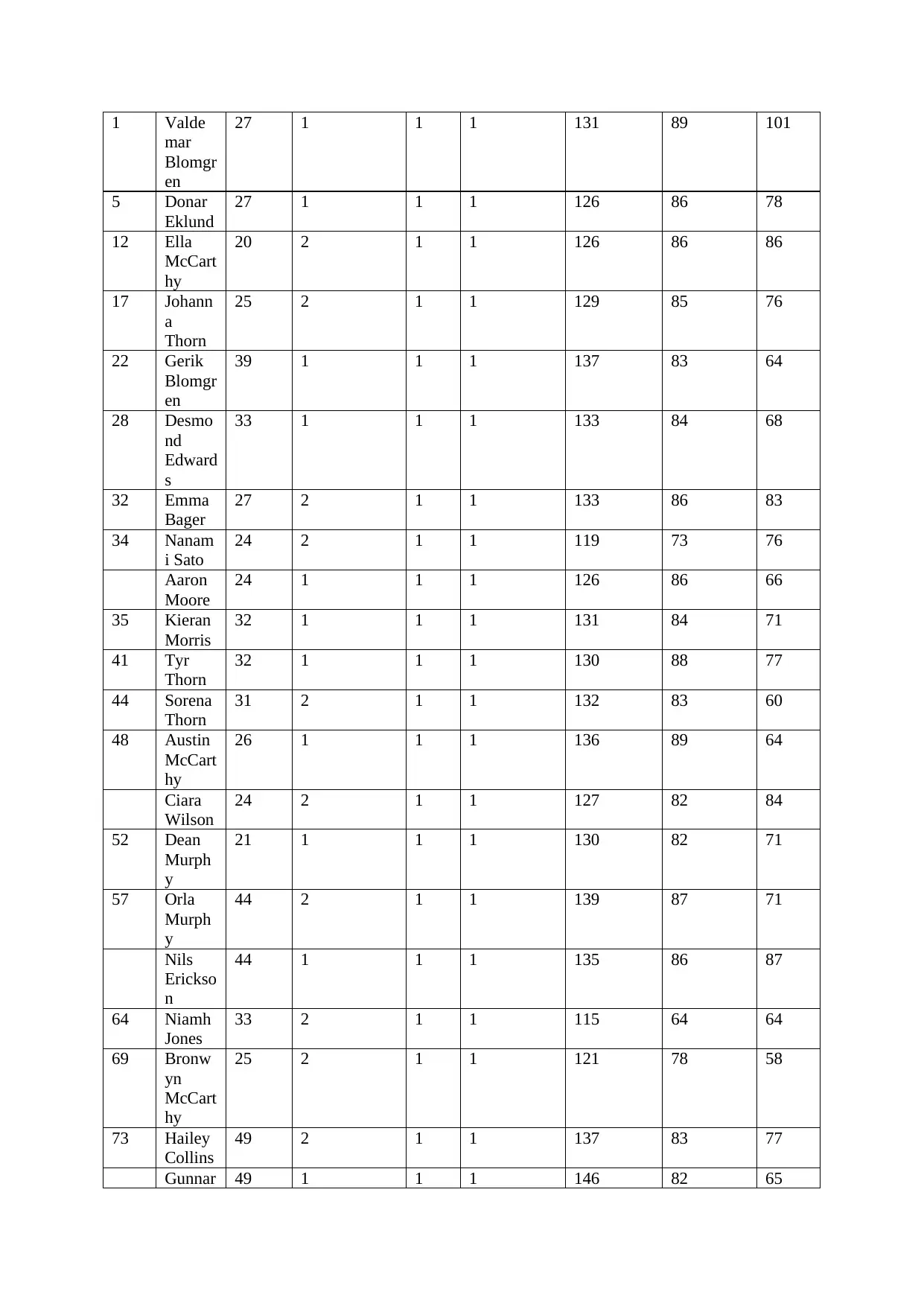
1 Valde
mar
Blomgr
en
27 1 1 1 131 89 101
5 Donar
Eklund
27 1 1 1 126 86 78
12 Ella
McCart
hy
20 2 1 1 126 86 86
17 Johann
a
Thorn
25 2 1 1 129 85 76
22 Gerik
Blomgr
en
39 1 1 1 137 83 64
28 Desmo
nd
Edward
s
33 1 1 1 133 84 68
32 Emma
Bager
27 2 1 1 133 86 83
34 Nanam
i Sato
24 2 1 1 119 73 76
Aaron
Moore
24 1 1 1 126 86 66
35 Kieran
Morris
32 1 1 1 131 84 71
41 Tyr
Thorn
32 1 1 1 130 88 77
44 Sorena
Thorn
31 2 1 1 132 83 60
48 Austin
McCart
hy
26 1 1 1 136 89 64
Ciara
Wilson
24 2 1 1 127 82 84
52 Dean
Murph
y
21 1 1 1 130 82 71
57 Orla
Murph
y
44 2 1 1 139 87 71
Nils
Erickso
n
44 1 1 1 135 86 87
64 Niamh
Jones
33 2 1 1 115 64 64
69 Bronw
yn
McCart
hy
25 2 1 1 121 78 58
73 Hailey
Collins
49 2 1 1 137 83 77
Gunnar 49 1 1 1 146 82 65
mar
Blomgr
en
27 1 1 1 131 89 101
5 Donar
Eklund
27 1 1 1 126 86 78
12 Ella
McCart
hy
20 2 1 1 126 86 86
17 Johann
a
Thorn
25 2 1 1 129 85 76
22 Gerik
Blomgr
en
39 1 1 1 137 83 64
28 Desmo
nd
Edward
s
33 1 1 1 133 84 68
32 Emma
Bager
27 2 1 1 133 86 83
34 Nanam
i Sato
24 2 1 1 119 73 76
Aaron
Moore
24 1 1 1 126 86 66
35 Kieran
Morris
32 1 1 1 131 84 71
41 Tyr
Thorn
32 1 1 1 130 88 77
44 Sorena
Thorn
31 2 1 1 132 83 60
48 Austin
McCart
hy
26 1 1 1 136 89 64
Ciara
Wilson
24 2 1 1 127 82 84
52 Dean
Murph
y
21 1 1 1 130 82 71
57 Orla
Murph
y
44 2 1 1 139 87 71
Nils
Erickso
n
44 1 1 1 135 86 87
64 Niamh
Jones
33 2 1 1 115 64 64
69 Bronw
yn
McCart
hy
25 2 1 1 121 78 58
73 Hailey
Collins
49 2 1 1 137 83 77
Gunnar 49 1 1 1 146 82 65
Paraphrase This Document
Need a fresh take? Get an instant paraphrase of this document with our AI Paraphraser
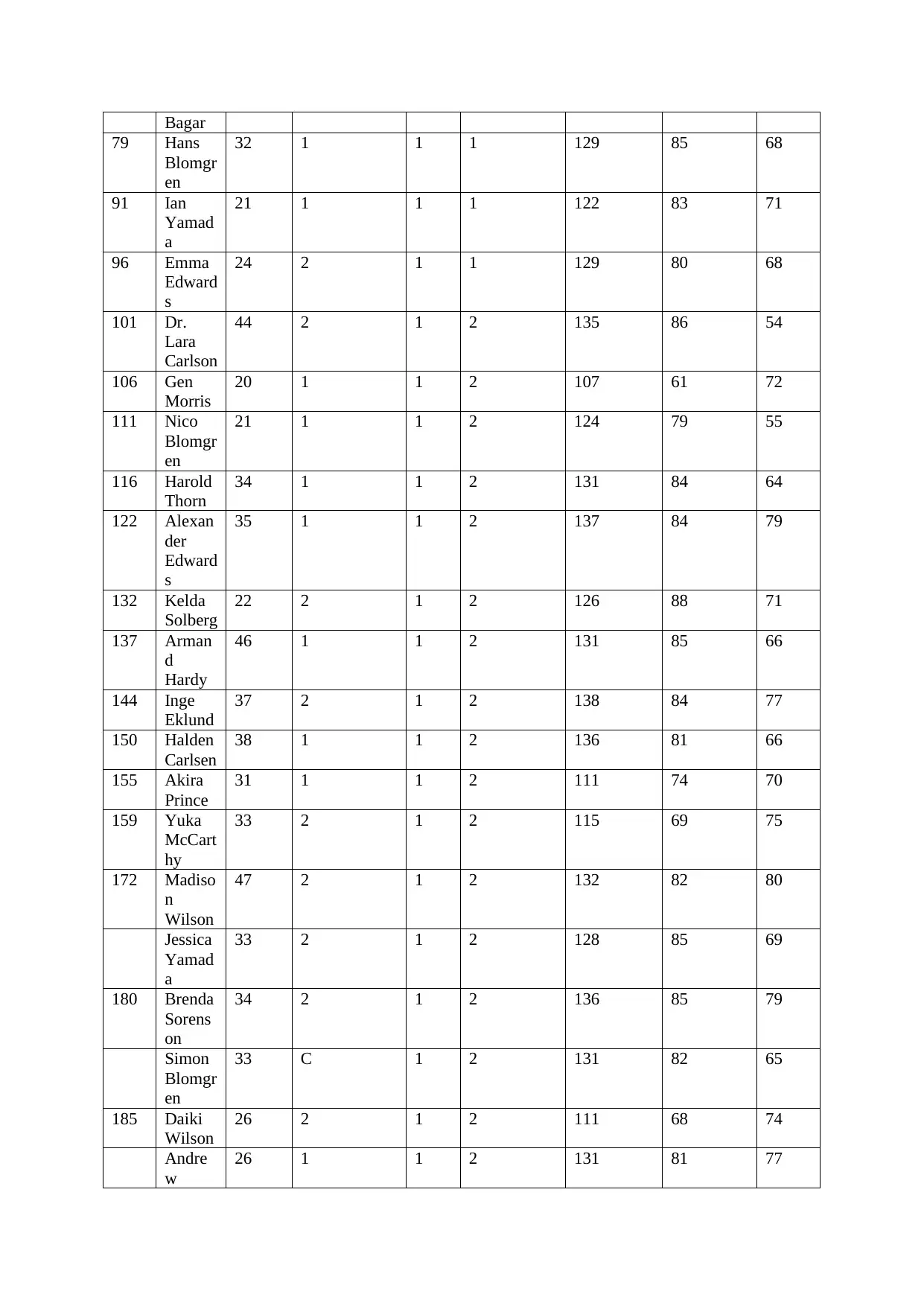
Bagar
79 Hans
Blomgr
en
32 1 1 1 129 85 68
91 Ian
Yamad
a
21 1 1 1 122 83 71
96 Emma
Edward
s
24 2 1 1 129 80 68
101 Dr.
Lara
Carlson
44 2 1 2 135 86 54
106 Gen
Morris
20 1 1 2 107 61 72
111 Nico
Blomgr
en
21 1 1 2 124 79 55
116 Harold
Thorn
34 1 1 2 131 84 64
122 Alexan
der
Edward
s
35 1 1 2 137 84 79
132 Kelda
Solberg
22 2 1 2 126 88 71
137 Arman
d
Hardy
46 1 1 2 131 85 66
144 Inge
Eklund
37 2 1 2 138 84 77
150 Halden
Carlsen
38 1 1 2 136 81 66
155 Akira
Prince
31 1 1 2 111 74 70
159 Yuka
McCart
hy
33 2 1 2 115 69 75
172 Madiso
n
Wilson
47 2 1 2 132 82 80
Jessica
Yamad
a
33 2 1 2 128 85 69
180 Brenda
Sorens
on
34 2 1 2 136 85 79
Simon
Blomgr
en
33 C 1 2 131 82 65
185 Daiki
Wilson
26 2 1 2 111 68 74
Andre
w
26 1 1 2 131 81 77
79 Hans
Blomgr
en
32 1 1 1 129 85 68
91 Ian
Yamad
a
21 1 1 1 122 83 71
96 Emma
Edward
s
24 2 1 1 129 80 68
101 Dr.
Lara
Carlson
44 2 1 2 135 86 54
106 Gen
Morris
20 1 1 2 107 61 72
111 Nico
Blomgr
en
21 1 1 2 124 79 55
116 Harold
Thorn
34 1 1 2 131 84 64
122 Alexan
der
Edward
s
35 1 1 2 137 84 79
132 Kelda
Solberg
22 2 1 2 126 88 71
137 Arman
d
Hardy
46 1 1 2 131 85 66
144 Inge
Eklund
37 2 1 2 138 84 77
150 Halden
Carlsen
38 1 1 2 136 81 66
155 Akira
Prince
31 1 1 2 111 74 70
159 Yuka
McCart
hy
33 2 1 2 115 69 75
172 Madiso
n
Wilson
47 2 1 2 132 82 80
Jessica
Yamad
a
33 2 1 2 128 85 69
180 Brenda
Sorens
on
34 2 1 2 136 85 79
Simon
Blomgr
en
33 C 1 2 131 82 65
185 Daiki
Wilson
26 2 1 2 111 68 74
Andre
w
26 1 1 2 131 81 77
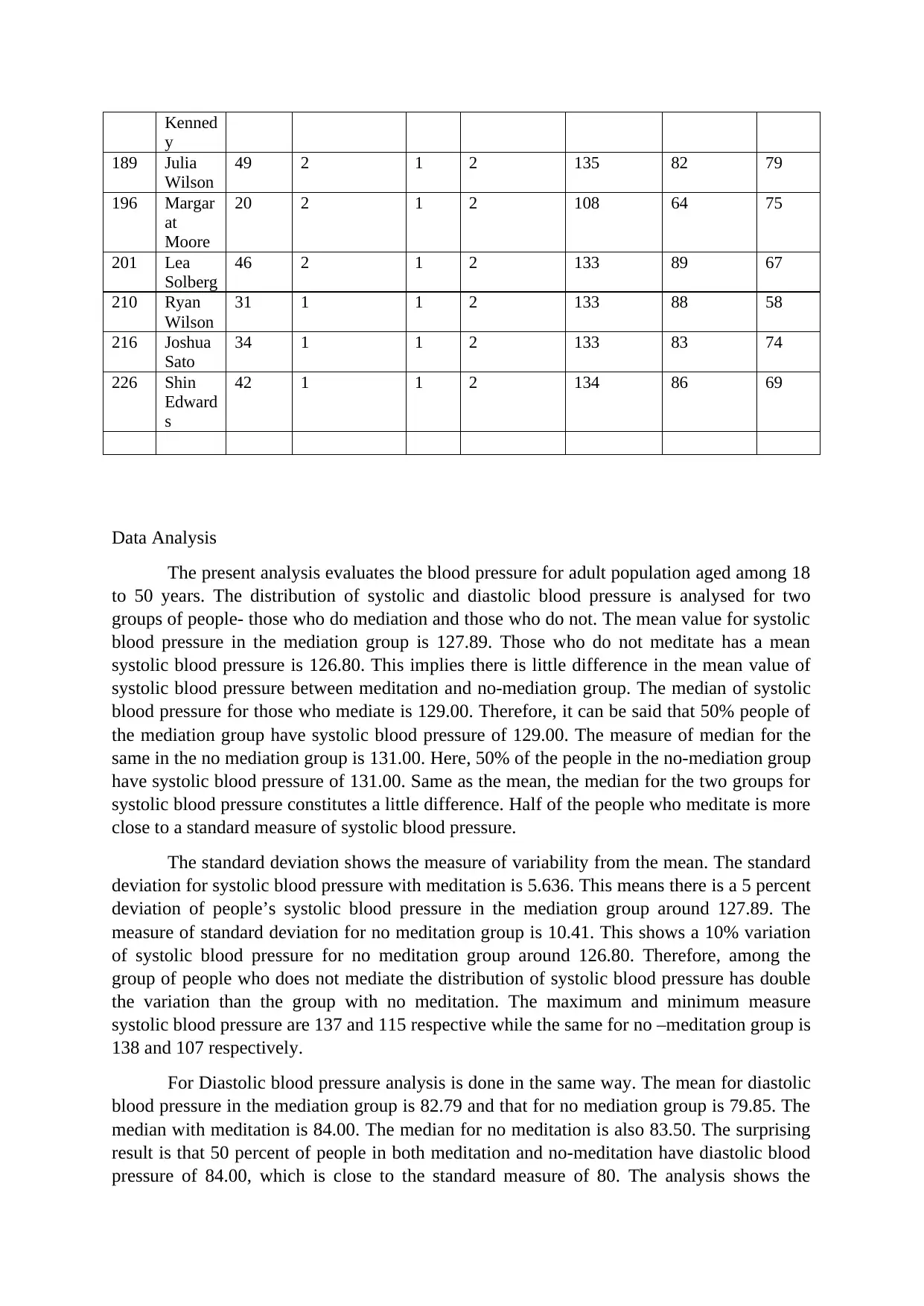
Kenned
y
189 Julia
Wilson
49 2 1 2 135 82 79
196 Margar
at
Moore
20 2 1 2 108 64 75
201 Lea
Solberg
46 2 1 2 133 89 67
210 Ryan
Wilson
31 1 1 2 133 88 58
216 Joshua
Sato
34 1 1 2 133 83 74
226 Shin
Edward
s
42 1 1 2 134 86 69
Data Analysis
The present analysis evaluates the blood pressure for adult population aged among 18
to 50 years. The distribution of systolic and diastolic blood pressure is analysed for two
groups of people- those who do mediation and those who do not. The mean value for systolic
blood pressure in the mediation group is 127.89. Those who do not meditate has a mean
systolic blood pressure is 126.80. This implies there is little difference in the mean value of
systolic blood pressure between meditation and no-mediation group. The median of systolic
blood pressure for those who mediate is 129.00. Therefore, it can be said that 50% people of
the mediation group have systolic blood pressure of 129.00. The measure of median for the
same in the no mediation group is 131.00. Here, 50% of the people in the no-mediation group
have systolic blood pressure of 131.00. Same as the mean, the median for the two groups for
systolic blood pressure constitutes a little difference. Half of the people who meditate is more
close to a standard measure of systolic blood pressure.
The standard deviation shows the measure of variability from the mean. The standard
deviation for systolic blood pressure with meditation is 5.636. This means there is a 5 percent
deviation of people’s systolic blood pressure in the mediation group around 127.89. The
measure of standard deviation for no meditation group is 10.41. This shows a 10% variation
of systolic blood pressure for no meditation group around 126.80. Therefore, among the
group of people who does not mediate the distribution of systolic blood pressure has double
the variation than the group with no meditation. The maximum and minimum measure
systolic blood pressure are 137 and 115 respective while the same for no –meditation group is
138 and 107 respectively.
For Diastolic blood pressure analysis is done in the same way. The mean for diastolic
blood pressure in the mediation group is 82.79 and that for no mediation group is 79.85. The
median with meditation is 84.00. The median for no meditation is also 83.50. The surprising
result is that 50 percent of people in both meditation and no-meditation have diastolic blood
pressure of 84.00, which is close to the standard measure of 80. The analysis shows the
y
189 Julia
Wilson
49 2 1 2 135 82 79
196 Margar
at
Moore
20 2 1 2 108 64 75
201 Lea
Solberg
46 2 1 2 133 89 67
210 Ryan
Wilson
31 1 1 2 133 88 58
216 Joshua
Sato
34 1 1 2 133 83 74
226 Shin
Edward
s
42 1 1 2 134 86 69
Data Analysis
The present analysis evaluates the blood pressure for adult population aged among 18
to 50 years. The distribution of systolic and diastolic blood pressure is analysed for two
groups of people- those who do mediation and those who do not. The mean value for systolic
blood pressure in the mediation group is 127.89. Those who do not meditate has a mean
systolic blood pressure is 126.80. This implies there is little difference in the mean value of
systolic blood pressure between meditation and no-mediation group. The median of systolic
blood pressure for those who mediate is 129.00. Therefore, it can be said that 50% people of
the mediation group have systolic blood pressure of 129.00. The measure of median for the
same in the no mediation group is 131.00. Here, 50% of the people in the no-mediation group
have systolic blood pressure of 131.00. Same as the mean, the median for the two groups for
systolic blood pressure constitutes a little difference. Half of the people who meditate is more
close to a standard measure of systolic blood pressure.
The standard deviation shows the measure of variability from the mean. The standard
deviation for systolic blood pressure with meditation is 5.636. This means there is a 5 percent
deviation of people’s systolic blood pressure in the mediation group around 127.89. The
measure of standard deviation for no meditation group is 10.41. This shows a 10% variation
of systolic blood pressure for no meditation group around 126.80. Therefore, among the
group of people who does not mediate the distribution of systolic blood pressure has double
the variation than the group with no meditation. The maximum and minimum measure
systolic blood pressure are 137 and 115 respective while the same for no –meditation group is
138 and 107 respectively.
For Diastolic blood pressure analysis is done in the same way. The mean for diastolic
blood pressure in the mediation group is 82.79 and that for no mediation group is 79.85. The
median with meditation is 84.00. The median for no meditation is also 83.50. The surprising
result is that 50 percent of people in both meditation and no-meditation have diastolic blood
pressure of 84.00, which is close to the standard measure of 80. The analysis shows the
⊘ This is a preview!⊘
Do you want full access?
Subscribe today to unlock all pages.

Trusted by 1+ million students worldwide
1 out of 18
Related Documents
Your All-in-One AI-Powered Toolkit for Academic Success.
+13062052269
info@desklib.com
Available 24*7 on WhatsApp / Email
![[object Object]](/_next/static/media/star-bottom.7253800d.svg)
Unlock your academic potential
Copyright © 2020–2025 A2Z Services. All Rights Reserved. Developed and managed by ZUCOL.





